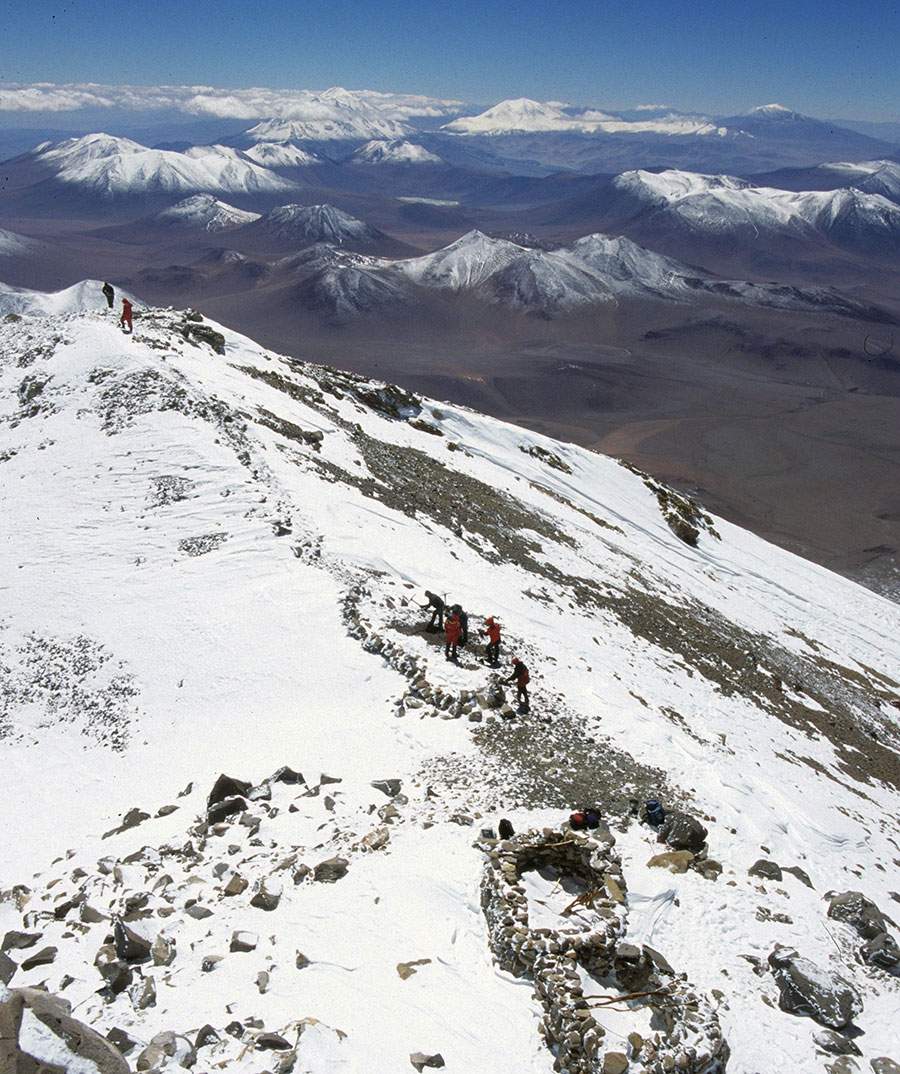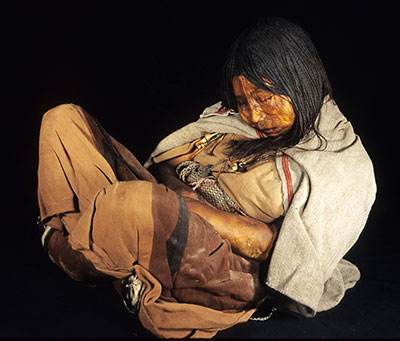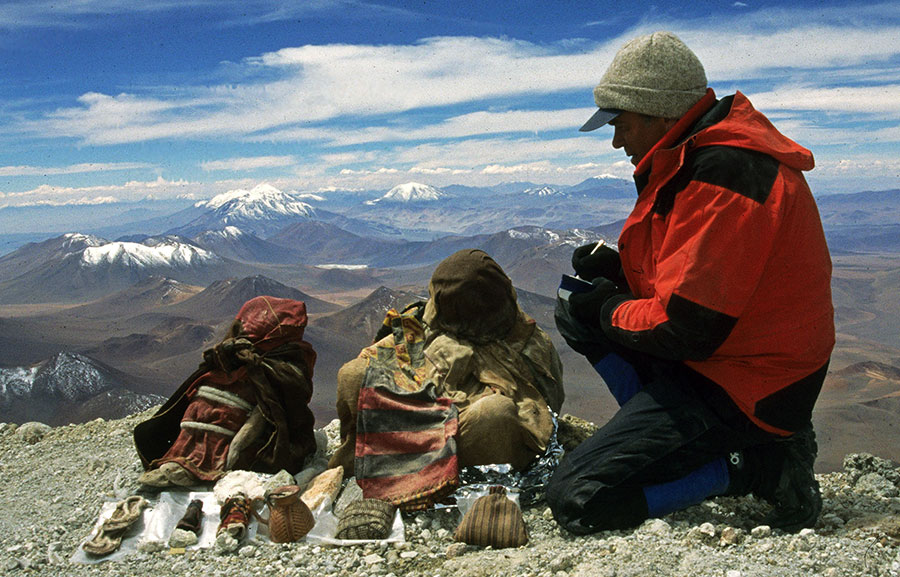The Incas are renowned for massive carved stone structures, the construction of thousands of miles of roads, and the establishment of one of the greatest empires in the ancient Americas. However, one of their achievements remains especially impressive. In just over sixty years (ca. 1470–1532 CE), they constructed stone structures on nearly 100 mountains ranging from 17,000 to 22,000 feet (ca. 6,700 m), and they did this in an area spanning 2,000 miles in the Andes.

It is the high altitude of so many ruins that has captured the public’s attention, not least because of the great amount of energy, organization, and in some cases specialized techniques necessary for constructing and maintaining structures at such heights. Even people who have lived all their lives at 13,000 feet (ca. 4,000 m)—the highest that permanent villages are normally found— have difficulty in reaching, let alone working at, altitudes over 17,000 feet (ca. 5,200 m).
Nowhere else on earth have archaeological remains been found at 22,000 feet and, indeed, this altitude would not even be reached again for four centuries after the Incas. The Incas not only managed to overcome physical challenges, such as climbing in thin air, altitude illness, and route-finding in difficult terrain, they also surmounted a psychological barrier brought on by a fear of the deities inhabiting sacred mountains.
The Andean Belief System
Mountain deities figured prominently in indigenous Andean beliefs and, among many traditional communities in the area, they still do. In the lands ruled by the Incas, mountain summits were selected as places for making the most important of all offerings—human sacrifices. Thanks to the difficulties encountered in even reaching high mountain summits, the offerings have provided rare evidence of Inca religion that has survived the impact of the Spanish conquistadors and looters over the centuries.

The Andean mountaintop mummies are unusual when compared to the world’s few other “ice mummies” such as the Iceman from the Alps (see article in this issue). Inca sacrificial victims often became frozen at the time of their deaths, not later when time had passed and the bodies had begun to decompose. Indeed, several chroniclers described “mummies” buried while they were still alive. On snow-laden mountains this has allowed for frozen bodies with little decomposition even after the passage of five centuries.
Several conditions contribute to the excellent preservation of the bodies. Most important is the continuous below-freezing temperatures found at the high altitudes of Andean peaks. Scientists have noted that some humidity is necessary for the preservation of the body; the total absence of moisture causes shrinkage and organic materials become brittle due to water loss. If volcanic ash surrounds the mummies, such as has occurred in some cases in the Andes, this also helps to inhibit the growth of bacteria, while maintaining moisture. And the rapid burial and freezing of the soil can result in a vapor barrier being created, further impeding decomposition. This unique combination of factors makes the Andean summits excellent places for the preservation of organic material such as on Llullaillaco, the volcano with the world’s highest archaeological site.
Human Sacrifice in the Mountains

The Spanish chroniclers described numerous Inca offerings to the gods: statues made of precious metals, finely woven textiles, and ceramics of distinctive Inca style, along with coca leaves, incense, food items, and alcoholic beverages. Although they noted that offerings could involve human sacrifices, it was not until the mid-1950s that scientists began paying serious attention to sacrifices made on mountains. In 1954, looters in Chile discovered the body of an Inca boy on the summit of El Plomo at about 17,000 feet (ca. 5,200 m). In 1964, the frozen body of a young man was found by mountain climbers at nearly 20,000 feet (ca. 6,000 m) on Mount El Toro (on the border between Chile and Argentina) and, in 1985, the frozen body of a seven-year-old boy was recovered from an Inca site at 17,400 feet (ca. 5,300 m) in Argentina on the lower slopes of Aconcagua, the highest peak in the Western Hemisphere. The resulting studies of these mummies laid the foundation for the development of longer-term scientific excavations being undertaken on the summits themselves during the 1990s. This resulted in the discovery of four exceptionally preserved Inca mummies on the mountains of Ampato (Peru) and Llullaillaco (Argentina).
Discoveries Frozen in Time
My interest in these sites began in 1980 when I first visited the Andes and realized that there was no reference to such high-altitude ruins in English-language archaeological textbooks and no archaeologist had spent more than a few hours at any of the sites. Furthermore, the most basic question still remained unanswered: Why had people 500 years ago constructed buildings and made offerings at such incredible heights?
Although early Spanish writers were mostly unaware of the high-altitude (over 17,000 feet/ca. 5,200 m) sites, they noted the importance of mountain deities throughout the Andes, even to people living well outside the Inca Empire. There were many reasons mountains were worshiped, but I found that a prominent belief was that mountains controlled meteorological phenomena, especially the flow of water and thus the fertility of crops and livestock. Such beliefs are based on ecological facts: rain, clouds, and lightning often originate in mountains, and rivers lead down from them.

When the Incas entered areas where these beliefs already existed, they constructed ritual sites on mountains that local people worshiped but had not climbed. In this way the Incas gained what was, in effect, greater control (political, religious, and economic) over the people and lands they conquered. The Incas were renowned for their worship of the sun and other state deities and they doubtless made offerings to them during their ceremonies. However, the ethno-historical and archaeological evidence led me to the conclusion that they selected peaks to build their structures because of the importance of the mountains themselves.
Between 1995 and 1997, we conducted a series of expeditions on the volcano Ampato (20,708 feet/6,312 m) in southwest Peru. When my assistant, Miguel Zarate, and I first climbed the peak, we were surprised to spot a mummy bundle lying on the ice just below the summit. I was momentarily stunned when we lifted up the bundle, and we found ourselves looking into the face of an Inca mummy. A girl (later called the Ice Maiden) was the first frozen body of an Inca female found in this area. Realizing that unique cultural and bioanthropological insights would be possible, we carefully recovered the mummy bundle.
The Ice Maiden had been sacrificed and buried together with female figurines of gold, silver, and Spondylus shell, as well as food items, woven bags, and pottery—all of which we found scattered along the slope. In Inca beliefs, such a sacrifice brought honor on the parents and an afterlife of bliss for the victim. The child would become deified and worshiped for generations as the villagers’ intermediary with the gods.
During an expedition to the summit of Llullaillaco (22,109 feet/6,739 m) in 1999, we undertook excavations within an Inca platform that revealed three burials and several offering assemblages. The Incas had placed a four to five-year-old boy on a folded tunic along with a Spondylus figurine of a male and a llama, and extra clothing.

We next found a feathered headdress on the head of a 13-year-old girl and, over her right shoulder, was draped a tunic associated with Inca nobility. Among other items, three female figurines made of gold, silver, and Spondylus shell were recovered next to her body.
It was the discovery of the third mummy that most affected us. We excavated a mummy bundle, finding that it had been hit by lightning while buried in its tomb. Once the bundle was on the surface, I saw that the head cloth was loose. As I drew it back, I found myself looking directly into a child’s face. None of us had expected to see her face, much less that it would exhibit a pensive stare. Later we learned that the four- to five-year-old girl’s internal tissues and organs, including her heart and brain, were exceptionally well preserved despite lightning having caused a cavity in her chest. The Incas had placed textile and ceramic items around her, along with
four female figurines made of gold, silver, and rare Spondylus shell.
The mummies and the other offerings found on Ampato and Llullaillaco significantly increased our knowledge of the religious practices and beliefs of the Incas, thanks not only to their excellent preservation, but also to the excavation and documentation of the sacrifices in their original contexts. These finds substantiate descriptions provided by early Spanish chroniclers and provide evidence on objects used in mountain rituals. Unfortunately, the continued looting of mountaintop shrines has meant that few mummies will remain untouched. There is still much to learn from the frozen mummies of the Andes, but little time remains before this unique cultural patrimony will be lost forever.
The Penn Museum in Peru

Museum Object Number(s): 26701 / 26671 / 26626
Acknowledgments
The author would like to thank the National Geographic Society for grants to undertake research on mountains in Peru and Argentina during 1983, 1995, and 1998–2000. Other organizations that supported his Andean research include the National Endowment for the Humanities, the Organization of American States, Rolex Montres, and the Social Science Research Council. Toyota generously donated a Land Cruiser and the Carrier Corporation made custom-built units for conserving the Ampato Ice Maiden.
It would be impossible to name all the individuals who in one way or another contributed to his research in the Andes over a period of 35 years. However, the following people provided financial support: Jeff and Darlene Anderson, Larry and Cathy Bogolub, Kit and Angie Goldsbury, George and Bicky Kellner, Joseph Richardson, and Doug and Laura Tipple.
Special thanks are due to José Antonio Chávez and Constanza Ceruti, who were co-directors with the author on several expeditions, and to Antonio Beorchia and Juan Schobinger, pioneers in the field of high-altitude archaeology.
Johan Reinhard, PH.D. received his doctorate in anthropology from the University of Vienna, Austria. As a National Geographic Explorer, his research focuses on the mountain peoples of the Andes and Himalayas.
For Further Reading
D’Altroy, T. The Incas. Oxford: Blackwell Publishers, 2002. Reinhard, J. The Ice Maiden: Inca Mummies, Mountain Gods, and Sacred Sites in the Andes. Washington, D.C.: National Geographic Society, 2005.
Reinhard, J., and C. Ceruti. Inca Rituals and Sacred Mountains: A Study of the World’s Highest Archaeological Sites. Los Angeles: Cotsen Institute of Archaeology, University of California, 2010.
